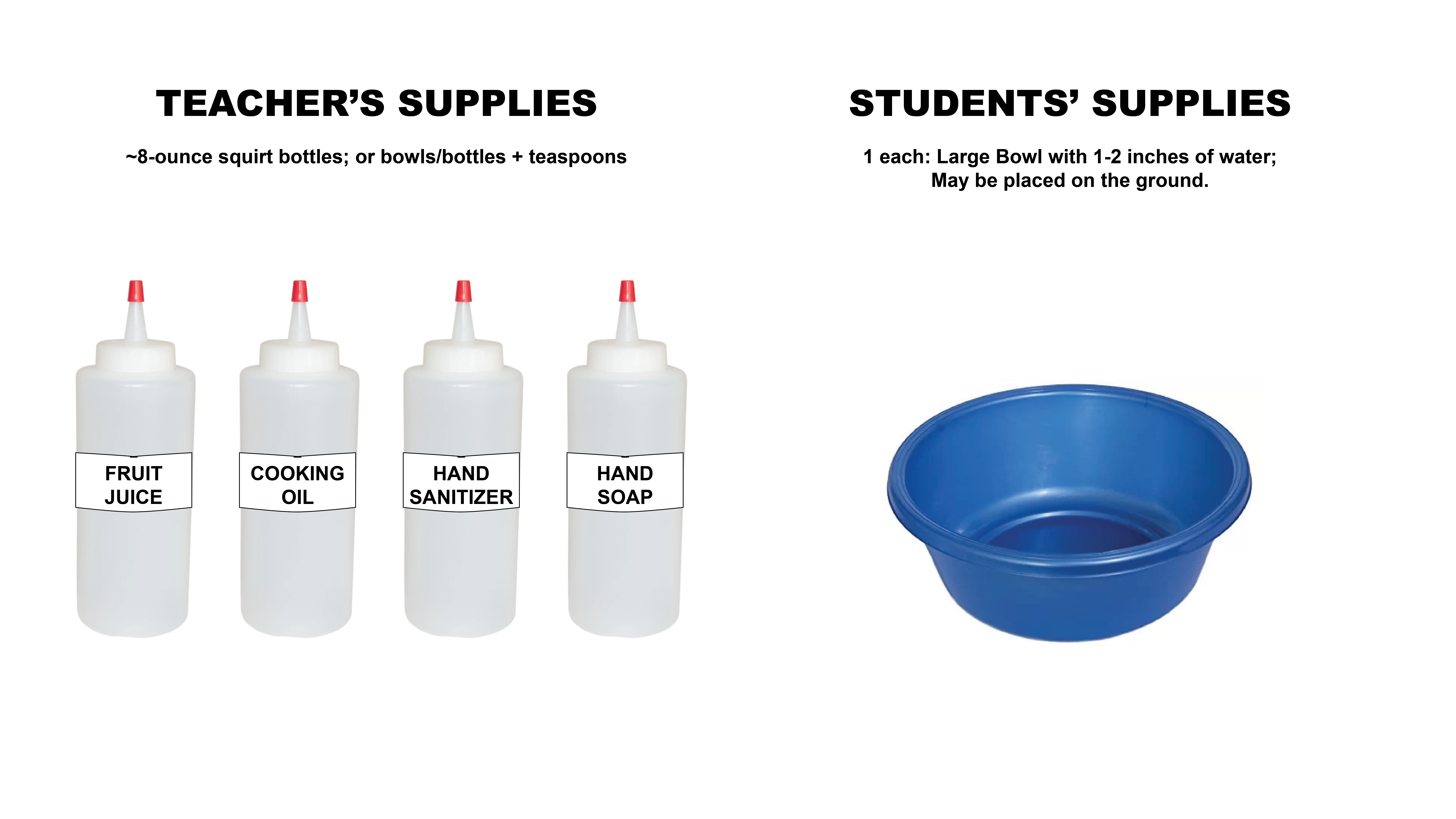Amazing Science VIDEO LESSON — Handwashing SCIENCE
Touching on the human microbiome and the world of microbes, this video lesson examines the science of handwashing. It includes hands-on activities that promote good handwashing techniques, using supplies commonly found in a typical home.
| AT-HOME VERSION | CLASSROOM VERSION |
Video time: 11m05s; Activity time: 15-25 min.
BEFORE RUNNING THIS VIDEO
- Determine which activity/activities your class will do
- Gather the equipment and supplies needed for your activity/activities (listed below)
- Print the printable materials (below)
Note — The activities for these lesson are designed to accommodate social distancing requirements
Play Video
The video for the classroom version of this lesson is designed to run uninterrupted.
VIDEO
ACTIVITY #1: hand Sanitizer vs soap & Water
Approximate time: 15-20 minutes. This activity may be done indoors or outdoors.
Instructions for the Activity #1 are also included in the "Activity #1 Instructions" PDF file, below.
EQUIPMENT AND SUPPLIES NEEDED
FOR EACH STUDENT:
1 Large bowl or small wash basin, with 1-2 inches of water
or access to a sink (much slower)
1 copy of NHS or WHO hand-washing steps (see PRINTABLES, below)
or teacher prints or projects a copy large enough for all to see.
FOR TEACHER:
- Four plastic squirt-bottles, ~8-ounces each, respectively containing:
- • Vegetable oil (e.g. canola oil; or butter, or margarine)
- • Fruit juice (the thicker the better)
• Hand sanitizer (or isopropyl alcohol; or a small amount of water, with no soap)
• Hand-soap
Activities Set-Up
PRINTABLE MATERIALS (Download and Print)
ACTIVITY #1 INSTRUCTIONS (pdf; 450kb)
Diagram of NHS or WHO Steps for Handwashing (pdf; 250kb) -- Contains:
INSTRUCTIONS
SET-UP:
- If using bowls/basins, have each student collect on basin, and fill it with 1-2" of water, and return to desk. If desired, bowl/basin may be placed on floor, rather than on desk.
ORIENTATION:
- Teacher informed students: there will be two substances tested: fruit juice, then cooking oil; for each substance, two cleansers will be used: hand sanitizer without water, then hand-washing soap (hand-soap) with water
FRUIT-JUICE:
- Teacher passes through room, and squirts ~1 tsp of fruit juice into one palm of each student; students should rub the fruit juice all over both sides of both hands, covering every part of both hands as thoroughly as possible
SANITIZER ON FRUIT JUICE:
- Teacher tells students that they will each receive a drop of hand sanitizer, and that each student should WAIT before spreading the hand sanitizer, until the teacher calls out the NHS or WHO handwashing steps. Teacher passes through the room again, this time, squirting ~1/2 - 1 tsp of hand sanitizer into the palm of each student. Teacher instructs students to -- WITHOUT USING WATER -- follow along as the teacher recites the NHS/WHO hand-washing steps.
- Teacher recites the NHS/WHO hand-washing steps; students perform each step when recited.
- Teacher instructs students to check hands for residual stickiness, and for residual smell.
- Teacher asks students whether they feel their hands are completely clean.
SOAP & WATER ON FRUIT JUICE:
- Teacher asks whether any students need more fruit juice on their hands; supplies as needed.
- Teacher tells students that they will each receive a drop of hand-soap, and that each student should WAIT before spreading the hand-soap, until the teacher calls out the NHS or WHO handwashing steps. Teacher passes through the room again, this time, squirting ~1/2 - 1 tsp of hand-soap into the palm of each student.
- Teacher instructs students to follow along as the teacher recites the NHS/WHO hand-washing steps.
- Teacher instructs students to close into a fist the hand that holds the hand-soap, then briefly dunk both hands into the water.
- Teacher recites the NHS/WHO hand-washing steps; students perform each step when recited.
- Teacher instructs students to check hands for residual stickiness, and for residual smell.
- Teacher asks students whether they feel their hands are completely clean.
- Students should do additional washing, if needed, to clean hands thoroughly.
COOKING OIL
- Repeat all step above, this time using cooking oil instead of fruit juice
- Teacher asks students to discuss which cleanser (hand sanitizer and hand-soap) worked better on each substance (fruit juice and cooking oil): Did one cleanser work best against both substances? Was one cleanser better against fruit juice and the other better against cooking oil? Which cleaning method left the hands feeling most completely clean?
DISCUSS
ACTIVITY #2: Drill Handwashing Steps, slow to fast
Approximate time: 5-10 minutes. This activity may be done indoors or outdoors.
EQUIPMENT AND SUPPLIES NEEDED
FOR EACH STUDENT:
Optional: 1 copy of NHS or WHO hand-washing steps (see PRINTABLES)
or (optional) teacher prints or projects a copy large enough for all to see.
FOR TEACHER:
- 1 copy of NHS or WHO hand-washing steps (see PRINTABLES)
Activities Set-Up
None.
PRINTABLE MATERIALS (Download and Print)
ACTIVITY #2 INSTRUCTIONS (pdf; 264kb)
Diagram of NHS or WHO Steps for Handwashing (pdf; 250kb)
INSTRUCTIONS
ORIENTATION:
Teacher informs students: we are going to play a game, where we walk through the steps of good handwashing, faster and faster, and see if we can all keep up!
We’ll “pantomime” the steps — meaning that we’ll just act them out.
Each time, I’ll call out the step, and you just have to follow along.
On the very last time, we’ll see if we can do it by memory.
We’ll pretend to get our hands wet, and then get a little soap, then we’ll start the timer, and start the step!
[OPTIONAL]: WARM-UP:
We’ll do each motion three times — we can count it like this (pantomime rubbing palms together): “1” (hands move in one direction), “and” (reverse motion), “2” (original direction), “and” (reverse), “three” (original direction), “and” (reverse) — and then we go straight to the next step!
Repeat, as needed.
REVIEW THE STEPS (NHS):
1. WET HANDS WITH WATER
2. SOAP DISPENSER
START TIMER!
(The “Call” — the steps)
3. “LATHER!” — PALMS TOGETHER (TO MAKE LATHER) (“1-and 2-and 3-and”)
4. “BACK” — BACKS OF HANDS WITH OPPOSITE PALMS:
RIGHT PALM ON LEFT BACK — Interlace fingers (EITHER IS FINE) (“1-and 2-and 3-and”)
LEFT PALM ON RIGHT BACK — Interlace fingers (“SWITCH!”) (“)
5. “PALMS!” — PALMS TOGETHER — Interlace fingers (“)
6. “KNUCKLES!”
LOCK KNUCKLES, RIGHT HAND ON TOP (EITHER IS FINE) (“)
LOCK KNUCKLES, LEFT HAND ON TOP (“SWITCH!”) (“)
7. “THUMBS!”
GRAB LEFT THUMB WITH RIGHT HAND (EITHER IS FINE) (“)
GRAB RIGHT THUMB WITH LEFT HAND ("SWITCH!") (“)
8. “FINGER-TIPS!”
RIGHT FINGER-TIPS ON LEFT PALM (EITHER IS FINE) (“)
LEFT FINGER-TIPS ON RIGHT PALM (“SWITCH!”) (“)
9. “WRISTS!”
GRAB LEFT WRIST WITH RIGHT HAND (EITHER IS FINE) (“)
GRAB RIGHT WRIST WITH LEFT HAND (“SWITCH!”) (“)
STOP TIMER!
10. RINSE HANDS WITH WATER
11. TURN OFF FAUCET (WITH ELBOW IF POSSIBLE)
12. DRY HANDS (WITH PAPER TOWEL, THEN THROW AWAY)
ACTIVITIY ROUNDS
Use “Call!” terms to cue next step on interval
Use “and switch” for next sub-step on interval
2-MINUTES
Step/Sub-Step Interval: 10 seconds
1-MiNUTE
Step/Sub-Step Interval: 5 seconds
48-SECONDS
Step/Sub-Step Interval: 4 seconds
30-SECONDS
Step/Sub-Step Interval: 2.5 seconds
———
30-SECONDS FROM MEMORY — REPEAT AS CLASS WISHES OR AS NEEDED
Step/Sub-Step Interval: 2.5 seconds
Call “switch” on interval (no cues)
EXTENSION ACTIVITIES (OPTIONAL)
• Printable Hand-Washing Word-Search (PDF; 52kb)
• Try the same hand-washing experiments (as in Activity #1) with DIFFERENT soaps! Do you have any guesses about which soap will work best; why do you think that? Which soap worked best, after testing? Consider trying each soap 2-3 times; are the results consistent?

